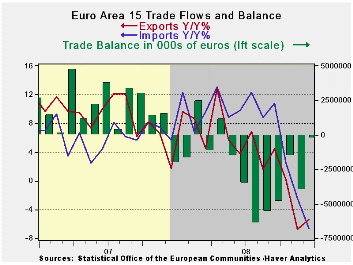 Global| Feb 17 2009
Global| Feb 17 2009Exports and Imports Plunge in the Euro Area as Deficit Contracts
Summary
Recession has hit the Euro Area trade flows hard as exports already lower by 6.8% lower in November fell by another 0.9% in December. But imports that fell by 4.8% on November fell by a further-chilling 3.9% in December. The [...]

Recession has hit the Euro Area trade flows hard as exports
already lower by 6.8% lower in November fell by another 0.9% in
December. But imports that fell by 4.8% on November fell by a
further-chilling 3.9% in December. The confluence of these trends
shrank the EMU trade deficit in December to Eur 257mln from Eur 4.0 Bln
in November. Yr/Yr exports are lower by 5.4% compared to imports which
are down by 6.6%. Over three months the annual rates of decline are
-35% for exports and -43% for imports. Over the last six months the
pace of decline has accelerated sharply. Yr/yr numbers do not begin to
show the depth of the problem.
German finance minister Steinbrueck warned that Euro-region
countries may be forced to bail out other members of the 16-nation bloc
that face problems refinancing their debt. “Some countries are slowly
getting into difficulties with their payments,” Steinbrueck said late
yesterday in a speech in Dusseldorf. “The euro-region treaties don’t
foresee any help for insolvent countries, but in reality the other
states would have to rescue those running into difficulty.” This
underscores the degree of difficulty of economic times in Europe. Also
underlining that tough sledding is the warning by the rating agency
Moody’s today. Moody’s cautions that banks with substantial lending
exposure to Eastern Europe could be downgraded. Thus another class of
assets (Eastern European loans) has gone bad. Of course the banks with
the most of this type of lending are European. Emerging Europe is being
called the ‘sub-prime’ of Europe.
| Euro Area 13 - Trade trends for goods | |||||
|---|---|---|---|---|---|
| m/m% | % Saar | ||||
| Dec-08 | Nov-08 | 3M | 6M | 12M | |
| Balance* | €€ (257) | €€ (4,005) | €€ (1,922) | €€ (3,760) | €€ (2,235) |
| Exports | |||||
| All Exp | -0.9% | -6.8% | -35.3% | -17.1% | -5.4% |
| Food and Drinks | -- | -3.0% | -7.1% | -3.3% | 1.6% |
| Raw materials | -- | -13.0% | -60.4% | -34.9% | -12.2% |
| MFG | -- | -4.0% | -24.7% | -10.8% | -6.6% |
| Imports | |||||
| All IMP | -3.9% | -4.8% | -43.4% | -21.0% | -6.6% |
| Food and Drinks | -- | -2.9% | -15.1% | -7.8% | -3.7% |
| Raw materials | -- | -0.4% | 4.5% | 4.8% | 8.3% |
| MFG | -- | -0.5% | -8.2% | -1.8% | -1.3% |
| *Eur mlns; mo or period average; Gray shaded areas lag one month | |||||
Robert Brusca
AuthorMore in Author Profile »Robert A. Brusca is Chief Economist of Fact and Opinion Economics, a consulting firm he founded in Manhattan. He has been an economist on Wall Street for over 25 years. He has visited central banking and large institutional clients in over 30 countries in his career as an economist. Mr. Brusca was a Divisional Research Chief at the Federal Reserve Bank of NY (Chief of the International Financial markets Division), a Fed Watcher at Irving Trust and Chief Economist at Nikko Securities International. He is widely quoted and appears in various media. Mr. Brusca holds an MA and Ph.D. in economics from Michigan State University and a BA in Economics from the University of Michigan. His research pursues his strong interests in non aligned policy economics as well as international economics. FAO Economics’ research targets investors to assist them in making better investment decisions in stocks, bonds and in a variety of international assets. The company does not manage money and has no conflicts in giving economic advice.






